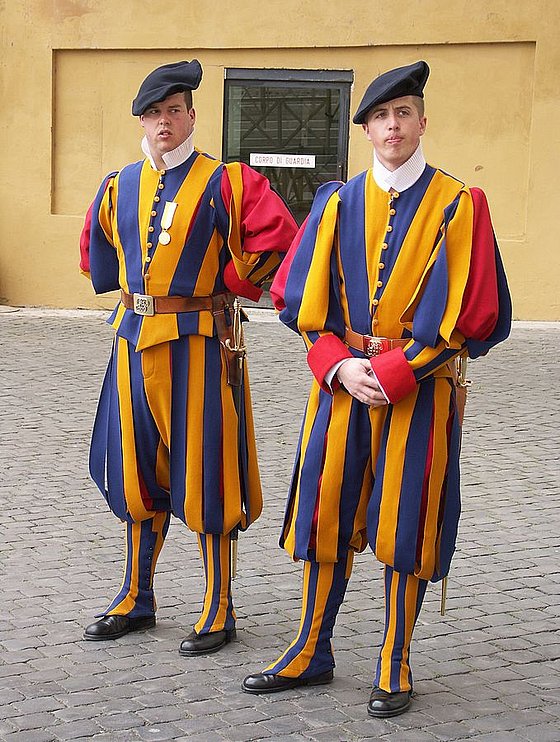
The Swiss Guard
PD. Dr. Arne Karsten / History
Photo: UniService Transfer
The sturdy peasant boys from the high alpine valleys
Historian Dr. Arne Karsten on the Swiss Guard in Rome
Nowadays, security services are used everywhere, for example to protect celebrities or politicians from danger. A worldwide known unit has been doing this since the early 16th century for the papal sovereign: the Swiss Guard. Historian Arne Karsten knows its history and the eventful development of the former peasant boys from the Swiss cantons.
Young men from poor backgrounds
Its official name is Pontificia Cohors Helvetia. "The Papal Swiss Guard is the only remaining armed military corps of the Holy See that originally consisted of strong peasant boys from the high alpine valleys," explains Karsten, "who gladly entered the military service of foreign rulers to protect them from any danger." And it wasn't just in the Vatican that the handsome fellows were welcome; the mercenary army also showed a presence in Austria, various Italian states and, above all, in France over a long period of time. During the time of Cardinal Richelieu, several companies of up to 6,000 men provided royal protection in the 17th century. "The background to this," Karsten explains, "is that the Swiss Confederation, as it is correct to say, because until the early 19th century there were no Swiss at all, consisted of a number of cantons, some of which were desperately poor. Today, Switzerland is a place of prosperity and wealth; it was different in the past. These mountain valleys offered just the bare necessities for survival, it was often the case that young men in particular had to seek their livelihood elsewhere, and so these soldier services to foreign rulers became a regular tradition."
Payment of the mercenary army also from Augsburg
The Augsburg merchant family Fugger plays an important role in relation to the Swiss Guard. "They invested their capital to finance the notoriously cash-strapped rulers," says Karsten, "and the borrowers, the debtors of the Augsburg Fuggers, included the popes in Rome." So it happened that the first 150 guardsmen were actually paid with money borrowed in Augsburg.
The tasks of the Swiss protection unit have hardly changed over the years, the expert reports. As before, they are essentially to ensure the safety of the papal sovereign as Garde du Corps, or bodyguards, if you want to translate it loosely. "In addition, they are guard-order and honor duties. They stand at the gates of access to the Vatican, they are on duty on all kinds of festive occasions, creating at the same time a framework of order as well as a dignified course of any festive event."
May 6, 1527 becomes the fateful day of the Guard
New Guardsmen are traditionally always sworn in on May 6. But this date has a tragic background and is therefore both a day of mourning and a day of honor. "On this day in 1527, Rome was conquered by German and Spanish mercenaries in the service of Charles V and then sacked for months," Karsten reports. "In fact, that's when the Swiss so fulfilled their mission to protect Pope Clement VII of the House of Medici that about three-quarters of the Swiss guardsmen lost their lives defending the pope and escaping to Castel Sant'Angelo. Since that day, the so-called Sacco di Roma, in which the unity proved beyond measure and saved the papal sovereign, this date is taken as an occasion to perform the annual re-swearing."

Swiss Guard in uniform (CC-BY-SA 3.0)
Traditions
Traditions play an important role in the Swiss Guard. Already the text of the oath formula has not changed until today. It states, among other things: "I swear to serve faithfully, honestly and honorably the reigning Pope [name of Pope] and his rightful successors, and to devote myself with all my strength to them, ready, if need be, to lay down my life for them myself." Today, the service is rather arduous in terms of the strenuous routine tasks, which include standing guard for hours with a halberd (hybrid of a cutting and stabbing weapon, editor's note) held out, a relic of earlier times. "The armament is already very contradictory," Karsten states, because, "on the one hand, extraordinarily traditional, they carry a halberd and a rapier when guarding the two entrance gates to Vatican City as well as the entrance stairs to the Vatican palaces. As designated bodyguards, they also carry a pistol underneath or next to it, and pepper spray for 'small` operations." And then, of course, there's the clothing. The guardsmen have two uniforms, one of them Renaissance-style in velvet with puffed sleeves, a stylization and variation of a 15th-century Medici warrior costume that even comes with an additional breastplate on feast days. "The breastplate is then joined by the morion helmet (open helmet type without visor in the form of Spanish iron hats - editor's note -)," adds Karsten, because of course the task of the Swiss Guards is also a decorative one. One could always see that during visits to Rome that tourists liked to have themselves photographed at the Porta Sancta Martha, left of St. Peter's Basilica, with the guardsmen in gala uniform. "Besides that, however, there is also the small service uniform. This is plain medium blue and is worn for everyday duty. On the way to the Vatican Library or the papal secret archives, for example, you pass the Swiss in the morning, are asked where you want to go and then very friendly with a "Grüezi", with the hand thereby on the cap, let through," laughs the Vatican connoisseur.
Sharp and faithful - always!
To recruit young guardsmen, the Swiss Guard is now also taking new approaches. The video presentation for this is very modern. The motto is: Acriter et fideliter - semper! (Sharp and faithful - always!) "This is the traditional self-image of the Swiss Guards. The reliability in the sense of willingness to perform, the 'sharp` denotes the close attention, the attentiveness in the service of the Pope and, on the other hand, the faithfulness, which in the tradition of the Swiss Guards has always been praised and proven throughout Europe. The most famous example was in 1792, the storming of the Tuileries, the city palace of the French kings. On August 10, several hundred Swiss Guardsmen sacrificed their lives in defense of this castle against the rebellious mob of French revolutionary supporters." And because even in our time the dangers do not decrease, in 2018 the target strength of the guardsmen in the Vatican was even increased.
Admission requirements
But not every young man meets the admission requirements, which Karsten lists as follows: "You must, of course, be Catholic, be 1.74 meters tall, have a blameless reputation and have completed Swiss military service." For just under 15600 euros in annual salary, many Swiss serve honorably in the small Roman state between graduation and professional careers. "From my research time in Rome, I'm still friends with a former Swiss Guardsman from the canton of Graubünden whose father was already a Swiss Guardsman," Karsten concludes, "who served two years in the Guard after school and before studying history in Rome, actually took up a degree afterwards, and chose a papal Roman topic for his thesis."
Uwe Blass
PD Dr. Arne Karsten (*1969) studied art history, history and philosophy in Göttingen, Rome and Berlin. From 2001 to 2009 he was a research assistant at the Institute for Art and Image History at Humboldt University Berlin. Since the winter semester of 2009, he has been teaching as a junior professor, and since his habilitation in 2016, as a private lecturer in modern history at Bergische Universität.
